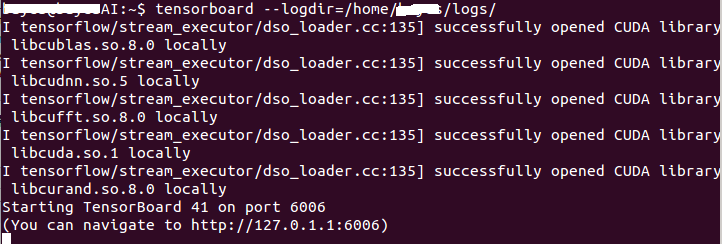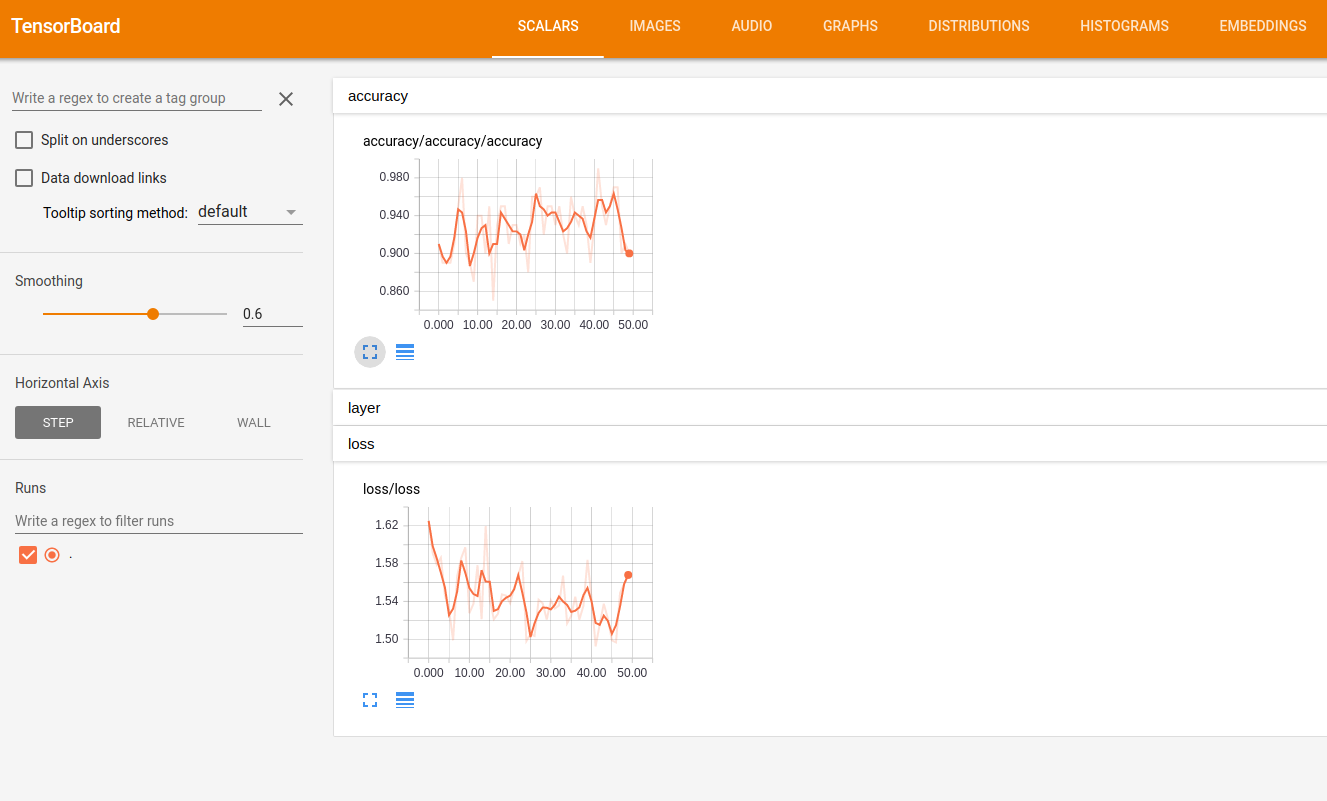Tensorflow學習教程------tensorboard網絡運行和可視化
阿新 • • 發佈:2017-10-09
predict 運行 optimizer ace 127.0.0.1 hot 瀏覽器中 test tdd
tensorboard可以將訓練過程中的一些參數可視化,比如我們最關註的loss值和accuracy值,簡單來說就是把這些值的變化記錄在日誌裏,然後將日誌裏的這些數據可視化。
首先運行訓練代碼
#coding:utf-8 import tensorflow as tf from tensorflow.examples.tutorials.mnist import input_data #載入數據集 mnist = input_data.read_data_sets("MNIST_data", one_hot=True) #每個批次的大小 batch_size = 100 #計算一共有多少個批次n_batch = mnist.train.num_examples // batch_size #參數概要 傳入一個參數可以計算這個參數的各個相關值 def variable_summaries(var): with tf.name_scope(‘summaries‘): mean = tf.reduce_mean(var) tf.summary.scalar(‘mean‘, mean)#平均值 with tf.name_scope(‘stddev‘): stddev = tf.sqrt(tf.reduce_mean(tf.square(var - mean))) tf.summary.scalar(‘stddev‘, stddev)#標準差 tf.summary.scalar(‘max‘, tf.reduce_max(var))#最大值 tf.summary.scalar(‘min‘, tf.reduce_min(var))#最小值 tf.summary.histogram(‘histogram‘, var)#直方圖 with tf.name_scope(‘input‘): #定義兩個placeholder x = tf.placeholder(tf.float32, [None,784],name=‘x-input‘) #輸入圖像 y = tf.placeholder(tf.float32, [None,10],name=‘y-input‘) #輸入標簽 #創建一個簡單的神經網絡 784個像素點對應784個數 因此輸入層是784個神經元 輸出層是10個神經元 不含隱層 #最後準確率在92%左右 with tf.name_scope(‘layer‘): with tf.name_scope(‘wights‘): W = tf.Variable(tf.zeros([784,10]),name = ‘W‘) #生成784行 10列的全0矩陣 variable_summaries(W) with tf.name_scope(‘biases‘): b = tf.Variable(tf.zeros([1,10]),name=‘b‘) variable_summaries(b) with tf.name_scope(‘softmax‘): prediction = tf.nn.softmax(tf.matmul(x,W)+b) #二次代價函數 #loss = tf.reduce_mean(tf.square(y-prediction)) #交叉熵損失 with tf.name_scope(‘loss‘): loss =tf.reduce_mean(tf.nn.softmax_cross_entropy_with_logits(labels =y,logits = prediction)) tf.summary.scalar(‘loss‘,loss) #使用梯度下降法 #train_step = tf.train.GradientDescentOptimizer(0.2).minimize(loss) train_step = tf.train.AdamOptimizer(1e-3).minimize(loss) #學習率一般設置比較小 收斂速度快 #初始化變量 init = tf.global_variables_initializer() #結果存放在布爾型列表中 #argmax能給出某個tensor對象在某一維上的其數據最大值所在的索引值 with tf.name_scope(‘accuracy‘): with tf.name_scope(‘correct_prediction‘): correct_prediction = tf.equal(tf.argmax(y,1), tf.argmax(prediction,1)) with tf.name_scope(‘accuracy‘): accuracy = tf.reduce_mean(tf.cast(correct_prediction,tf.float32)) tf.summary.scalar(‘accuracy‘,accuracy) #合並所有的summary merged = tf.summary.merge_all() with tf.Session() as sess: sess.run(init) writer = tf.summary.FileWriter(‘/home/xxx/logs/‘,sess.graph) #定義記錄日誌的位置 for epoch in range(50): for batch in range(n_batch): # batch_xs,batch_ys = mnist.train.next_batch(batch_size) summary,_ = sess.run([merged,train_step],feed_dict={x:batch_xs,y:batch_ys}) writer.add_summary(summary,epoch) #將summary epoch 寫入到writer acc = sess.run(accuracy,feed_dict={x:mnist.test.images, y:mnist.test.labels}) print ("Iter " + str(epoch) + ",Testing Accuracy " + str(acc))
註意我將訓練日誌保存在 /home/xxx/logs/ 路徑下,打開終端,輸入以下命令 tensorboard --logdir=/home/xxx/logs/ 如下圖所示

在瀏覽器中輸入127.0.0.1:6006,可以看到可視化效果,如loss和accuracy的變化折線圖

Tensorflow學習教程------tensorboard網絡運行和可視化
